Abstract
The gill withdrawal reflex of Aplysia has been used as a model for studying the neuronal mechanisms of habituation, a behavioral plasticity. We have assessed the contribution of neuromuscular facilitation, an elementary synaptic plasticity, during habituation of the reflex by recording gill muscle potentials, which we show are caused by excitatory junctional potentials. These potentials show systematic frequency-dependent changes in amplitude. The gill withdrawal evoked by central motor neuron firing during each habituation trial is determined by facilitation of the excitatory junctional potentials during the trial and the facilitated state of the initial excitatory junctional potential in a trial, determined by neuron activity prior to the trial. The neuromuscular junctions, therefore, act like a frequency-dependent amplifier of central motor activity. They are fully responsive to the dynamic changes of motor neuron firing that occurs during habituation and especially after dishabituation.
Full text
PDF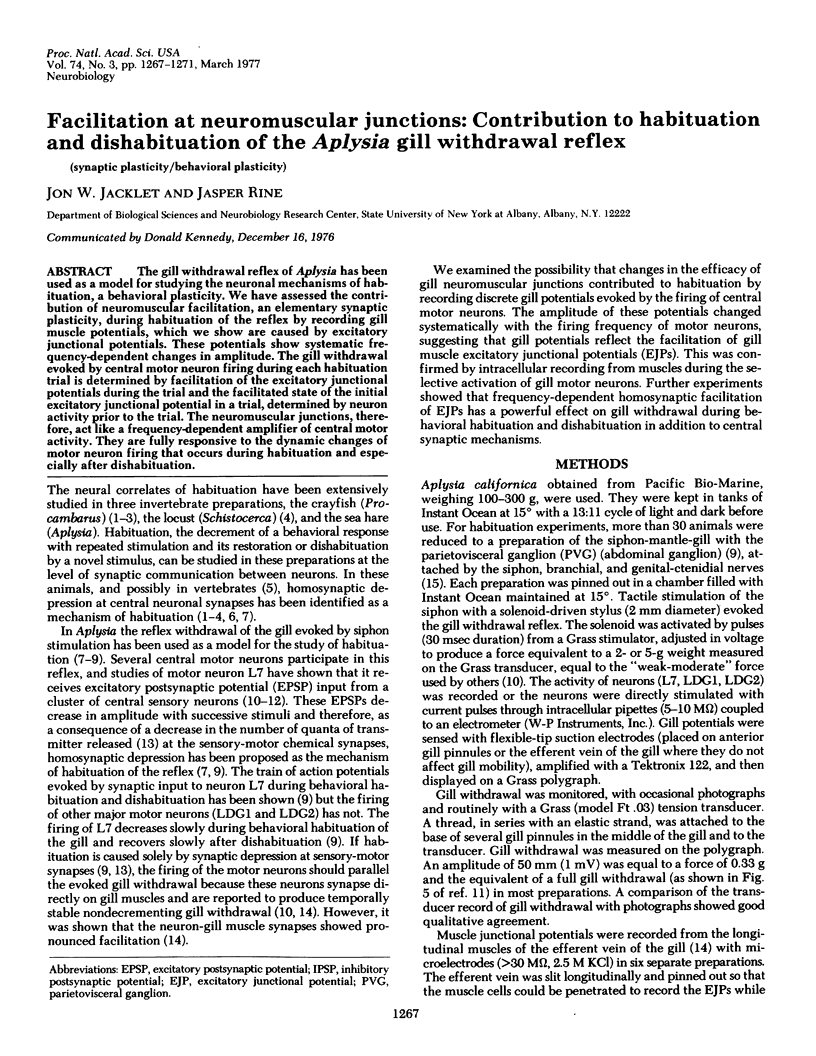
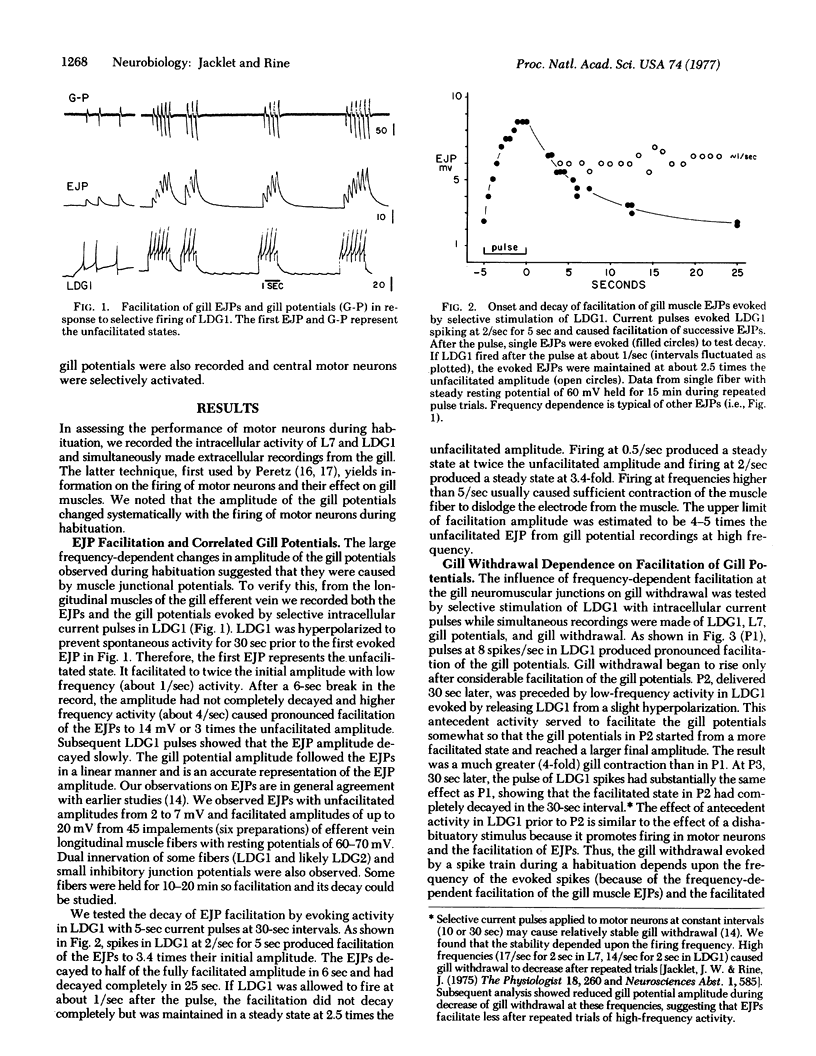
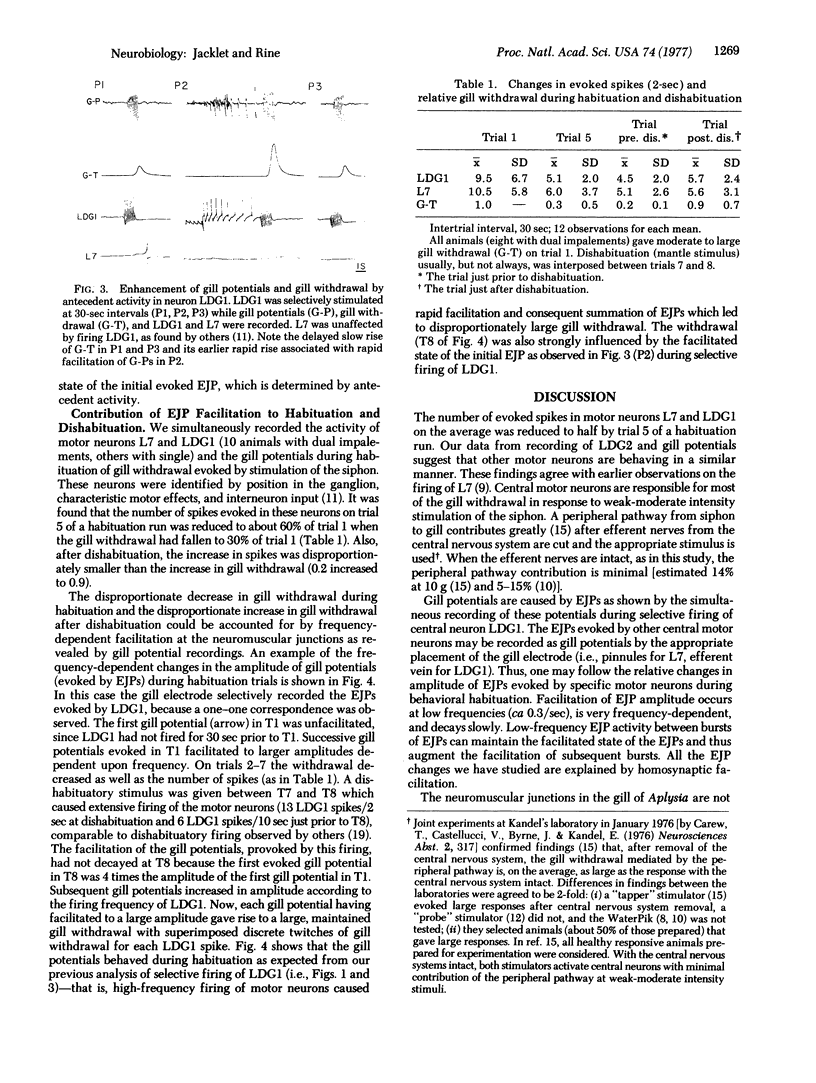
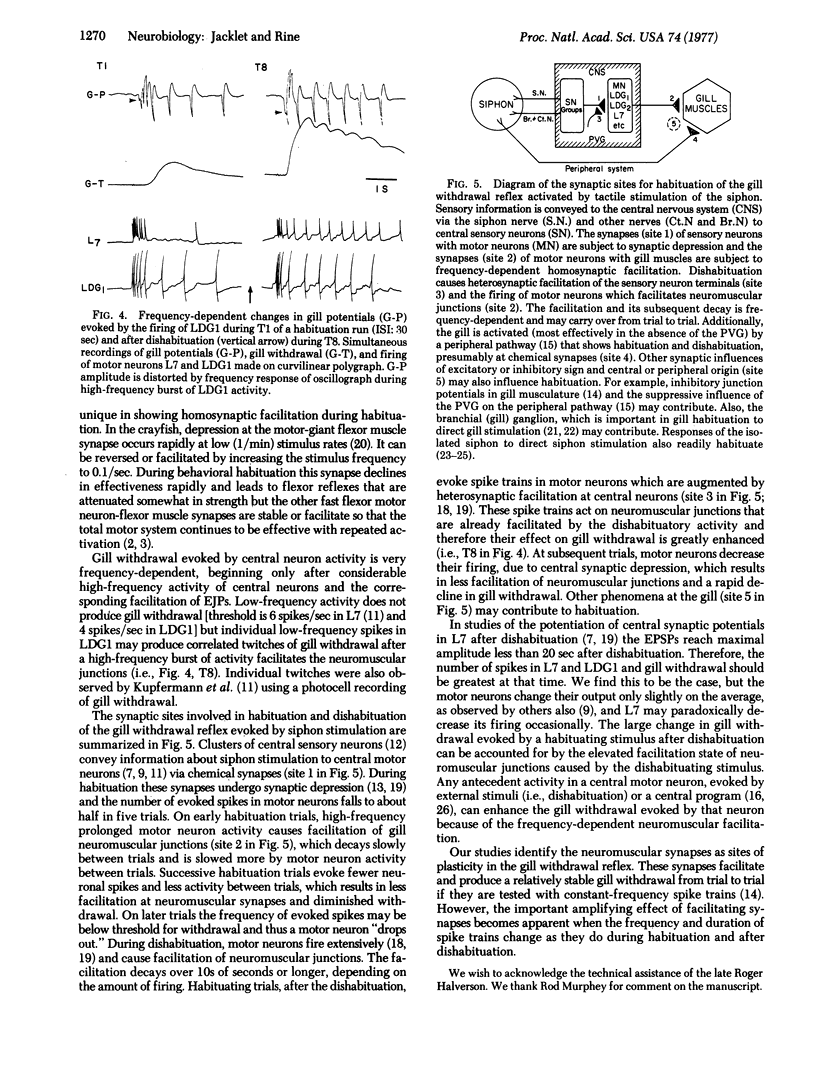
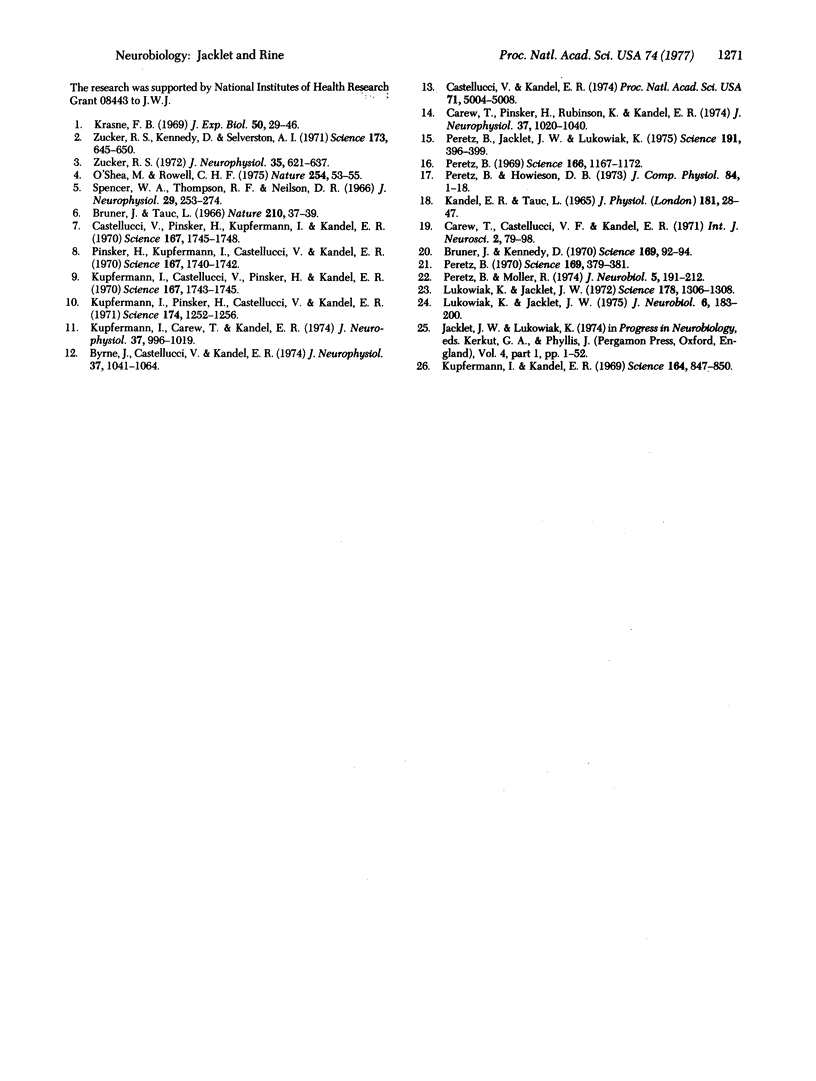
Images in this article
Selected References
These references are in PubMed. This may not be the complete list of references from this article.
- Bruner J., Dkennedy D. Habituation: occurrence at a neuromuscular junction. Science. 1970 Jul 3;169(3940):92–94. doi: 10.1126/science.169.3940.92. [DOI] [PubMed] [Google Scholar]
- Bruner J., Tauc L. Habituation at the synaptic level in Aplysia. Nature. 1966 Apr 2;210(5031):37–39. doi: 10.1038/210037a0. [DOI] [PubMed] [Google Scholar]
- Byrne J., Castellucci V., Kandel E. R. Receptive fields and response properties of mechanoreceptor neurons innervating siphon skin and mantle shelf in Aplysia. J Neurophysiol. 1974 Sep;37(5):1041–1064. doi: 10.1152/jn.1974.37.5.1041. [DOI] [PubMed] [Google Scholar]
- Carew T. J., Castellucci V. F., Kandel E. R. An analysis of dishabituation and sensitization of the gill-withdrawal reflex in Aplysia. Int J Neurosci. 1971 Aug;2(2):79–98. doi: 10.3109/00207457109146995. [DOI] [PubMed] [Google Scholar]
- Carew T. J., Pinsker H., Rubinson K., Kandel E. R. Physiological and biochemical properties of neuromuscular transmission between identified motoneurons and gill muscle in Aplysia. J Neurophysiol. 1974 Sep;37(5):1020–1040. doi: 10.1152/jn.1974.37.5.1020. [DOI] [PubMed] [Google Scholar]
- Castellucci V. F., Kandel E. R. A quantal analysis of the synaptic depression underlying habituation of the gill-withdrawal reflex in Aplysia. Proc Natl Acad Sci U S A. 1974 Dec;71(12):5004–5008. doi: 10.1073/pnas.71.12.5004. [DOI] [PMC free article] [PubMed] [Google Scholar]
- Castellucci V., Pinsker H., Kupfermann I., Kandel E. R. Neuronal mechanisms of habituation and dishabituation of the gill-withdrawal reflex in Aplysia. Science. 1970 Mar 27;167(3926):1745–1748. doi: 10.1126/science.167.3926.1745. [DOI] [PubMed] [Google Scholar]
- Kandel E. R., Tauc L. Mechanism of heterosynaptic facilitation in the giant cell of the abdominal ganglion of Aplysia depilans. J Physiol. 1965 Nov;181(1):28–47. doi: 10.1113/jphysiol.1965.sp007743. [DOI] [PMC free article] [PubMed] [Google Scholar]
- Krasne F. B. Excitation and habituation of the crayfish escape reflex: the depolarizing response in lateral giant fibres of the isolated abdomen. J Exp Biol. 1969 Feb;50(1):29–46. doi: 10.1242/jeb.50.1.29. [DOI] [PubMed] [Google Scholar]
- Kupfermann I., Carew T. J., Kandel E. R. Local, reflex, and central commands controlling gill and siphon movements in Aplysia. J Neurophysiol. 1974 Sep;37(5):996–1019. doi: 10.1152/jn.1974.37.5.996. [DOI] [PubMed] [Google Scholar]
- Kupfermann I., Castellucci V., Pinsker H., Kandel E. Neuronal correlates of habituation and dishabituation of the gill-withdrawal reflex in Aplysia. Science. 1970 Mar 27;167(3926):1743–1745. doi: 10.1126/science.167.3926.1743. [DOI] [PubMed] [Google Scholar]
- Kupfermann I., Kandel E. R. Neuronal controls of a behavioral response mediated by the abdominal ganglion of Aplysia. Science. 1969 May 16;164(3881):847–850. doi: 10.1126/science.164.3881.847. [DOI] [PubMed] [Google Scholar]
- Kupfermann I., Pinsker H., Castellucci V., Kandel E. R. Central and peripheral control of gill movements in Aplysia. Science. 1971 Dec 17;174(4015):1252–1256. doi: 10.1126/science.174.4015.1252. [DOI] [PubMed] [Google Scholar]
- Lukowiak K., Jacklet J. W. Habituation and dishabituation: interactions between peripheral and central nervous systems in Aplysia. Science. 1972 Dec 22;178(4067):1306–1308. doi: 10.1126/science.178.4067.1306. [DOI] [PubMed] [Google Scholar]
- Lukowiak K., Jacklet J. Habituation and dishabituation mediated by the peripheral and central neural circuits of the siphon of Aplysia. J Neurobiol. 1975 Mar;6(2):183–200. doi: 10.1002/neu.480060206. [DOI] [PubMed] [Google Scholar]
- O'Shea M., Rowell C. H. Protection from habituation by lateral inhibition. Nature. 1975 Mar 6;254(5495):53–55. doi: 10.1038/254053a0. [DOI] [PubMed] [Google Scholar]
- Peretz B. Central neuron initiation of periodic gill movements. Science. 1969 Nov 28;166(3909):1167–1172. doi: 10.1126/science.166.3909.1167. [DOI] [PubMed] [Google Scholar]
- Peretz B. Habituation and dishabituation in the absence of a central nervous system. Science. 1970 Jul 24;169(3943):379–381. doi: 10.1126/science.169.3943.379. [DOI] [PubMed] [Google Scholar]
- Peretz B., Jacklet J. W., Lukowi K. Habituation of reflexes in Aplysia: contribution of the peripheral and central nervous systems. Science. 1976 Jan 30;191(4225):396–399. doi: 10.1126/science.1246622. [DOI] [PubMed] [Google Scholar]
- Peretz B., Moller R. Control of habituation of the withdrawal reflex by the gill ganglion in Aplysia. J Neurobiol. 1974;5(3):191–212. doi: 10.1002/neu.480050303. [DOI] [PubMed] [Google Scholar]
- Pinsker H., Kupfermann I., Castellucci V., Kandel E. Habituation and dishabituation of the gill-withdrawal reflex in Aplysia. Science. 1970 Mar 27;167(3926):1740–1742. doi: 10.1126/science.167.3926.1740. [DOI] [PubMed] [Google Scholar]
- Spencer W. A., Thompson R. F., Neilson D. R., Jr Decrement of ventral root electrotonus and intracellularly recorded PSPs produced by iterated cutaneous afferent volleys. J Neurophysiol. 1966 Mar;29(2):253–274. doi: 10.1152/jn.1966.29.2.253. [DOI] [PubMed] [Google Scholar]
- Zucker R. S. Crayfish escape behavior and central synapses. II. Physiological mechanisms underlying behavioral habituation. J Neurophysiol. 1972 Sep;35(5):621–637. doi: 10.1152/jn.1972.35.5.621. [DOI] [PubMed] [Google Scholar]
- Zucker R. S., Kennedy D., Selverston A. I. Neuronal circuit mediating escape responses in crayfish. Science. 1971 Aug 13;173(3997):645–650. doi: 10.1126/science.173.3997.645. [DOI] [PubMed] [Google Scholar]



